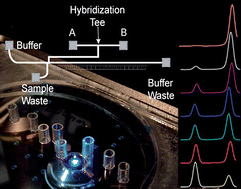There is significant interest in developing on-chip DNA hybridization assays to leverage the advantages of lab-on-a-chip systems, which include smaller sample and reagent volumes, faster processing speeds, and greater opportunities for large-scale integration. While much research has explored ways to integrate DNA microarrays on-chip, little work has been done to incorporate hybridization with existing microscale separation platforms. We present the first separation of single-stranded and double-stranded oligonucleotides in a nanofluidic device. We couple this separation with free-solution hybridization to develop a simple, electrokinetic technique that detects DNA hybridization without sample labeling. The technique is used both to detect target DNA sequences and to quantitatively measure hybridization kinetics. To demonstrate the method, we measured the second order reaction coefficient of complementary 20-mer oligonucleotides as a function of sodium ion concentration, which ranged from 0.0048 mol−1·sec−1 at 5 mM sodium to 0.42 mol−1·sec−1 at 50 mM. We also distinguished between a pair of complementary oligonucleotides and a pair with a single nucleotide mismatch, observing a two-fold difference in hybridization rate. Additionally, we observed a relative change in the mobility of single-stranded and double-stranded DNA with increasing sodium concentration, suggesting that our device may provide a useful platform for studying biomolecule transport in nanochannels.

You have access to this article
 Please wait while we load your content...
Something went wrong. Try again?
Please wait while we load your content...
Something went wrong. Try again?


 Please wait while we load your content...
Please wait while we load your content...